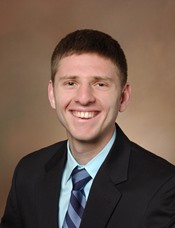Program Information
CT Ventilation Imaging: The New Clinical Reality of Functional Avoidance and Response Assessment in Lung Cancer Radiation Therapy

T Yamamoto
Y Vinogradskiy
J Bayouth
J Kipritidis
T Yamamoto1*, Y Vinogradskiy2*, J Bayouth3*, J Kipritidis4*, (1) University of California Davis Medical Center, Sacramento, CA, (2) University of Colorado Denver, Aurora, CO, (3) University of Wisconsin, Madison, WI, (4) The University of Sydney, Sydney, AU
Presentations
4:30 PM : Introduction to CT Ventilation Imaging: Principles, Validation and Clinical Translation - T Yamamoto, Presenting Author4:52 PM : Applications, Validation, Clinical Endpoints and Opportunities for CT Ventilation - Y Vinogradskiy, Presenting Author
5:14 PM : Spatial distributions of radiation induced pulmonary changes can be modeled and utilized for image-guided planning and therapy to improve pulmonary function preservation and hence the therapeutic ratio for lung cancer - J Bayouth, Presenting Author
5:36 PM : The VAMPIRE challenge: Preliminary results from a multi-institutional study of CT ventilation image accuracy - J Kipritidis, Presenting Author
TU-H-202-0 (Tuesday, August 2, 2016) 4:30 PM - 6:00 PM Room: 202
CT ventilation imaging is an exciting functional imaging modality that combines four-dimensional computed tomography (4DCT) and deformable image registration (DIR) to provide exquisite ventilation maps of the lung. CT ventilation imaging can be used for:
(1) Functional avoidance in thoracic radiation therapy,
(2) Imaging longitudinal changes in regional lung function for treatment assessment and adaptation,
(3) Image-assisted diagnosis of non-oncologic respiratory diseases.
CT ventilation imaging uses CT, a predominantly anatomic imaging modality, and through imaging processing creates functional images. CT ventilation imaging provides functional images that are higher resolution, faster and cheaper to perform than the clinical standard, SPECT. Indeed the number of CT ventilation abstracts presented at the AAPM meeting has been doubling every two years. With the world’s-first clinical trial of CT ventilation functional image-guided radiation therapy now underway, the first dedicated scientific symposium will educate and stimulate AAPM members from both radiology and radiation oncology.
This symposium will compare the foundations of CT ventilation imaging with competing MRI, PET and SPECT ventilation imaging methods, and details the first clinical trial of CT ventilation imaging for functional avoidance in lung cancer radiation therapy. The spatial-temporal nature of pulmonary ventilation, response maps to radiation and the design of predictive models will be presented. Validation efforts and challenges will also be discussed, from clinical outcome correlations in single time point and longitudinal studies, to cross-modality image comparisons in the first multi-institutional CT ventilation imaging challenge.
The panel will discuss the future role of CT ventilation imaging, and what level of physiologic validation is needed for applications in radiation oncology and beyond.
Program: Moderator: Paul Keall
Speaker 1. Tokihiro Yamamoto, Ph.D.: Introduction to CT ventilation imaging: Principles, validation and clinical translation
Speaker 2: Jenia Vinogradskiy, Ph.D.: Applications, validation, clinical endpoints and opportunities for CT ventilation
Speaker 3. John Bayouth, Ph.D.: Spatial distributions of radiation induced pulmonary changes can be modeled and utilized for image-guided planning and therapy to improve pulmonary function preservation and hence the therapeutic ratio for lung cancer
Speaker 4. John Kipritidis, Ph.D.: The VAMPIRE challenge: Preliminary results from a multi-institutional study of CT ventilation image accuracy.
Panel discussion: What are the key current scientific questions for CT ventilation imaging? What barriers need to be overcome prior to wider clinical use in radiation oncology and beyond?
Learning objectives:
1. Learn the principles of CT ventilation imaging and how ventilation images are acquired with MRI, PET and SPECT
2. Understand the methods used to benchmark CT ventilation and the correlations between CT ventilation imaging and clinical outcomes
3. Recognize the clinical applications of CT ventilation imaging in radiation oncology and beyond
Funding Support, Disclosures, and Conflict of Interest: Australian NHMRC Fellowship. Australian NSW Cancer Institute Fellowship.; Y. Vinogradskiy, The authors acknowledge NIH R01CA200817 grant and Stat of Colorado grant.; T. Yamamoto, This study was supported in part by the American Cancer Society and the Dean of the University of California Davis School of Medicine (ACS IRG-95-125-13). Philips Radiation Oncology Systems loaned us a research version of the Pinnacle3 treatment planning system.; J. Bayouth, Funding support from NCI R01 CA166703; J. Kipritidis, This work has been supported by a Cancer Institute NSW Early Career Fellowship and an NHMRC Australia Fellowship. No commercial funding was received for this work.
Handouts
- 115-31615-387514-119203.pdf (T Yamamoto)
- 115-31616-387514-119333.pdf (Y Vinogradskiy)
- 115-31617-387514-118289.pdf (J Bayouth)
- 115-31618-387514-119332.pdf (J Kipritidis)
Contact Email:




